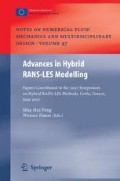Abstract
Although LES is a highly promising simulation technique, it still suffers from extremely large resources required for the resolution of the near-wall region, especially for high-Re flows. That is the main motivation for setting up hybrid LES-RANS methods. Whereas RANS suits reasonably well to attached boundary layers, requiring much less CPU-time and memory than LES, the latter is recommended for complex large-scale flow phenomena, which RANS often fails to predict correctly. Both characteristics are combined in hybrid LES-RANS methods to obtain an optimal solution at lower cost. Meanwhile a variety of different hybrid concepts were proposed including DES. In the present study a non-zonal approach based on two different but unique models is preferred. The predefinition of RANS and LES regions is avoided and a gradual transition between both methods takes place which weakens the problem of setting up an appropriate coupling strategy. The new hybrid LES-RANS approach relies on a one-equation model for the turbulent kinetic energy in both modes. At this phase the model is of linear type. In addition to this linear eddy-viscosity model (LEVM), an explicit algebraic Reynolds stress model (EARSM) is applied in the RANS mode in order to account for the Reynolds stress anisotropy. This insertion leads to a non-linear model. The linear version is used for comparison in order to emphasize the advantages of the non-linear formulation. Both model variants have been tested on the basis of the standard plane channel flow and the flow over a periodic arrangement of hills.
Access this chapter
Tax calculation will be finalised at checkout
Purchases are for personal use only
Preview
Unable to display preview. Download preview PDF.
References
Breuer, M.: Large–Eddy Simulation of the Sub–Critical Flow Past a Circular Cylinder: Numerical and Modeling Aspects. Int. J. for Num. Methods in Fluids 28, 1281–1302 (1998)
Breuer, M., et al.: A Comparative Study of the Turbulent Flow Over a Periodic Arrangement of Smoothly Contoured Hills, Sixth Int. In: ERCOFTAC Workshop on DNS and LES: DLES-6, Poitiers, France, September 12–14, 2005. ERCOFTAC Series, vol. 10, pp. 635–642. Springer, Heidelberg (2006)
Breuer, M., Jaffrézic, B., Arora, K.: Hybrid LES-RANS Technique Based on a One-Equation Near-Wall Model. J. Theoretical and Computational Fluid Dynamics (in press, 2007)
Breuer, M.: New Reference Data for the Hill Flow Test Case, personal communication (2005), http://www.hy.bv.tum.de/DFG-CNRS/
Fröhlich, J., et al.: Highly Resolved Large–Eddy Simulation of Separated Flow in a Channel with Streamwise Periodic Constrictions. J. Fluid Mech. 526, 19–66 (2005)
Jaffrézic, B., et al.: Towards LES-RANS-Coupling for Complex Flows with Separation. In: ESAIM Proceedings, CEMRACS 2005, Computational Aeroacoustics and CFD in Turbulent Flows, Marseille, France, July 18– August 26, 2005, vol. 16, pp. 89–113 (2007)
Moser, R.D., Kim, J., Mansour, N.N.: DNS of Turbulent Channel Flow up to Reτ=590. Phys. Fluids 28, 1281–1302 (1999)
Rodi, W., Mansour, N.N., Michelassi, V.: One-Equation Near-Wall Turbulence Modeling with the Aid of Direct Simulation Data. J. Fluids Engineering 115, 196–205 (1993)
Schumann, U.: Subgrid–Scale Model for Finite–Difference Simulations of Turbulent Flows in Plane Channels and Annuli. J. Computational Physics 18, 376–404 (1975)
Wallin, S., Johansson, A.V.: An Explicit Algebraic Reynolds Stress Model for Incompressible and Compressible Turbulent Flows. J. Fluid Mech. 403, 89–132 (2000)
Author information
Authors and Affiliations
Editor information
Rights and permissions
Copyright information
© 2008 Springer-Verlag Berlin Heidelberg
About this paper
Cite this paper
Breuer, M., Jaffrézic, B., Delgado, A. (2008). Hybrid LES-RANS Method Based on an Explicit Algebraic Reynolds Stress Model. In: Peng, SH., Haase, W. (eds) Advances in Hybrid RANS-LES Modelling. Notes on Numerical Fluid Mechanics and Multidisciplinary Design, vol 97. Springer, Berlin, Heidelberg. https://doi.org/10.1007/978-3-540-77815-8_5
Download citation
DOI: https://doi.org/10.1007/978-3-540-77815-8_5
Publisher Name: Springer, Berlin, Heidelberg
Print ISBN: 978-3-540-77813-4
Online ISBN: 978-3-540-77815-8
eBook Packages: EngineeringEngineering (R0)

